A quick report of my second day in Auckland, New Zealand
The objective was a trip to the restored island of Tiritiri Matangi, (37o
00.295S; 174o 954E; Elevation = 3') which
lies in the Hauraki Gulf, about an hour's cruise east of Auckland City.
Tiritiri was an island devoted to the raising of sheep until approximately 30
years ago. Before that it had been a Maori place, with remains of at least
two Pa's (Maori fortifications involved in intertribal warfare). Shell middens, like those of New England Wampanoags, are found here.
On a bright and calm morning, the tour boat left Auckland behind,

and moved around the most recent volcanic island that dates to about 600
years ago -- Rangitoto Island--en route to Tiritiri Matangi.

Viewed from all angles, Rangitoto is a most symmetrical island. The
peak contains a shallow crater, and there are still caves in the lava flows.
Its revegetation has been completed only in the last 25 years or so, and
features the "New Zealand Christmas Tree"--Pohutukawa. After passing
Rangitoto we encountered numerous sea birds, including a huge flock of
Fluttering Shearwaters, with many Gannets, and a few Blue Penguins. Blue
Penguins are the smallest species of penguins, and breed throughout much of New
Zealand. Unlike colonial penguins like Adelie's and Gentoos, Blue Penguins move
into wooded regions as single pairs, and nest in underground cavities, being
quite secretive.
When the boat reached Tiritiri, our group of about 13 intrepid explorers
followed our volunteer leader, Gerhard, for a walk through the dense
reestablished forest and over a very steeply dissected island that topped out at
about 300 feet above seal level.
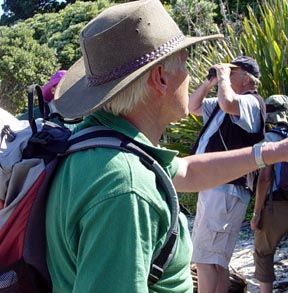 The
group included folks from California, Australia, New Zealand, Sweden, and The
Netherlands. Gerhard was an expert naturalist and pointed out the
dominant vegetation, including Cabbage Trees, New Zealand Flax, and the ever
present Pohutukawa trees. The Pohutukawa is called the New Zealand
Christmas Tree for its red flowers that open in December.
The
group included folks from California, Australia, New Zealand, Sweden, and The
Netherlands. Gerhard was an expert naturalist and pointed out the
dominant vegetation, including Cabbage Trees, New Zealand Flax, and the ever
present Pohutukawa trees. The Pohutukawa is called the New Zealand
Christmas Tree for its red flowers that open in December.
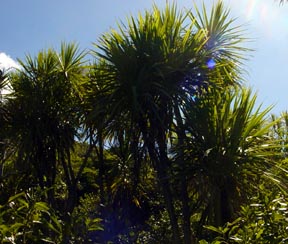
Cabbage Trees
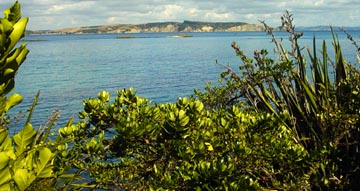
New Zealand Flax is the spiky plant on the right, it grows
throughout New Zealand, with leaves as tall as 6 or 8 feet. It was
formerly harvested and the fibers in the leaves used for twine and cordage.
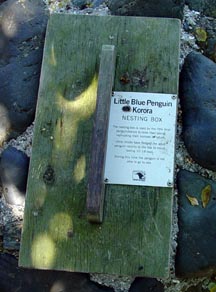 Tiritiri Matangi
is maintained by the New Zealand Department of Conservation, which has, with
significant volunteer help, restored the island to a semblance of its former
pristine shape. Much research goes on here, including the maintenance of
nesting sites for Blue Penguins that allows continual monitoring of their
nesting success. The wooden lid over the top of the subterranean nest can
be lifted to observe the young. The incubating parents exchange roles only
at night.
Tiritiri Matangi
is maintained by the New Zealand Department of Conservation, which has, with
significant volunteer help, restored the island to a semblance of its former
pristine shape. Much research goes on here, including the maintenance of
nesting sites for Blue Penguins that allows continual monitoring of their
nesting success. The wooden lid over the top of the subterranean nest can
be lifted to observe the young. The incubating parents exchange roles only
at night.
 I found the shore
near the Penguin sites to be interesting for the presence of succulents and
lichens encrusting boulders in the intertidal zone. Something you would
never see in New England. These lichens must be very salt tolerant!
I found the shore
near the Penguin sites to be interesting for the presence of succulents and
lichens encrusting boulders in the intertidal zone. Something you would
never see in New England. These lichens must be very salt tolerant!
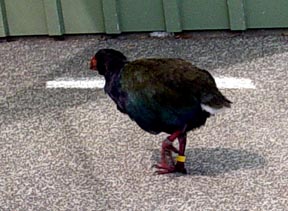 Along the beach
we encountered our first Takahe. This large flightless bird weighs up to
about 7 or 8 pounds, and is related to the coots or mud hens. Fully
terrestrial, it was threatened with extinction only a few years ago.
A relict population in the extreme southern part of the Fijordland district of
New Zealand provided a nucleus for the birds that are now found on Tiritiri.
After building up to a population of about 30 birds on Tirtiri, the present
number has declined to 18 at present. Apparently in denser
populations (30 was dense), the aggressive males kill subordinate males. The birds are very tame and approach
visitors, eagerly looking for handouts (not encouraged).
Along the beach
we encountered our first Takahe. This large flightless bird weighs up to
about 7 or 8 pounds, and is related to the coots or mud hens. Fully
terrestrial, it was threatened with extinction only a few years ago.
A relict population in the extreme southern part of the Fijordland district of
New Zealand provided a nucleus for the birds that are now found on Tiritiri.
After building up to a population of about 30 birds on Tirtiri, the present
number has declined to 18 at present. Apparently in denser
populations (30 was dense), the aggressive males kill subordinate males. The birds are very tame and approach
visitors, eagerly looking for handouts (not encouraged).
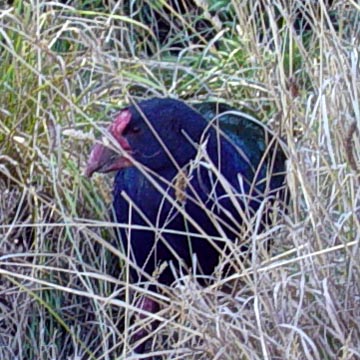
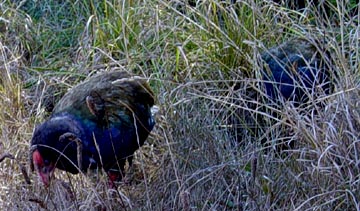
Some of the Pohutukawa trees on the island are large and substantial trees,
with the oldest having been dated to 800 or 1000 years old. They are
impressive, and must be doubly so when in bloom.
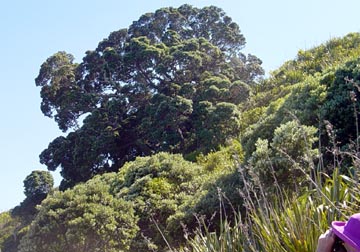
Among the many rare and unique birds seen on our trip were
Tui's (on the left and right pictures below), and the Bell Bird (on the right of
the left picture). The male Tui is a grackle size bird with iridescent
purple plumage, and a distinctive tuft of white feathers at the throat.
The Bell Bird, which is very abundant here has a very musical and loud call that
is as pleasant as any bird's can be.
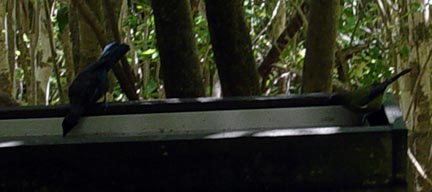
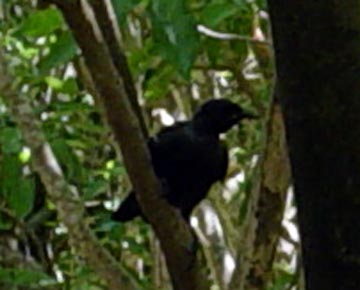
Other spectacular birds that we saw included Saddlebacks, New Zealand
Kingfisher, Stitch Bird, Fan Tail, Whiteheads, Red Crowned Parakeet,and the New
Zealand Robin. Not at all related to our native Robin, this little black
bird is exceptionally tame, and owes its name to its calls that do resemble
those of our robin.
While we didn't see the normally nocturnal Tuatara (Rhyncocephalian reptile)
or Spotted Kiwi, it was an extraordinary birding trip that I probably will never
see the likes of again. It was a wonderful day.



 The
group included folks from California, Australia, New Zealand, Sweden, and The
Netherlands. Gerhard was an expert naturalist and pointed out the
dominant vegetation, including Cabbage Trees, New Zealand Flax, and the ever
present Pohutukawa trees. The Pohutukawa is called the New Zealand
Christmas Tree for its red flowers that open in December.
The
group included folks from California, Australia, New Zealand, Sweden, and The
Netherlands. Gerhard was an expert naturalist and pointed out the
dominant vegetation, including Cabbage Trees, New Zealand Flax, and the ever
present Pohutukawa trees. The Pohutukawa is called the New Zealand
Christmas Tree for its red flowers that open in December.

 Tiritiri Matangi
is maintained by the New Zealand Department of Conservation, which has, with
significant volunteer help, restored the island to a semblance of its former
pristine shape. Much research goes on here, including the maintenance of
nesting sites for Blue Penguins that allows continual monitoring of their
nesting success. The wooden lid over the top of the subterranean nest can
be lifted to observe the young. The incubating parents exchange roles only
at night.
Tiritiri Matangi
is maintained by the New Zealand Department of Conservation, which has, with
significant volunteer help, restored the island to a semblance of its former
pristine shape. Much research goes on here, including the maintenance of
nesting sites for Blue Penguins that allows continual monitoring of their
nesting success. The wooden lid over the top of the subterranean nest can
be lifted to observe the young. The incubating parents exchange roles only
at night. I found the shore
near the Penguin sites to be interesting for the presence of succulents and
lichens encrusting boulders in the intertidal zone. Something you would
never see in New England. These lichens must be very salt tolerant!
I found the shore
near the Penguin sites to be interesting for the presence of succulents and
lichens encrusting boulders in the intertidal zone. Something you would
never see in New England. These lichens must be very salt tolerant! Along the beach
we encountered our first Takahe. This large flightless bird weighs up to
about 7 or 8 pounds, and is related to the coots or mud hens. Fully
terrestrial, it was threatened with extinction only a few years ago.
A relict population in the extreme southern part of the Fijordland district of
New Zealand provided a nucleus for the birds that are now found on Tiritiri.
After building up to a population of about 30 birds on Tirtiri, the present
number has declined to 18 at present. Apparently in denser
populations (30 was dense), the aggressive males kill subordinate males. The birds are very tame and approach
visitors, eagerly looking for handouts (not encouraged).
Along the beach
we encountered our first Takahe. This large flightless bird weighs up to
about 7 or 8 pounds, and is related to the coots or mud hens. Fully
terrestrial, it was threatened with extinction only a few years ago.
A relict population in the extreme southern part of the Fijordland district of
New Zealand provided a nucleus for the birds that are now found on Tiritiri.
After building up to a population of about 30 birds on Tirtiri, the present
number has declined to 18 at present. Apparently in denser
populations (30 was dense), the aggressive males kill subordinate males. The birds are very tame and approach
visitors, eagerly looking for handouts (not encouraged).



